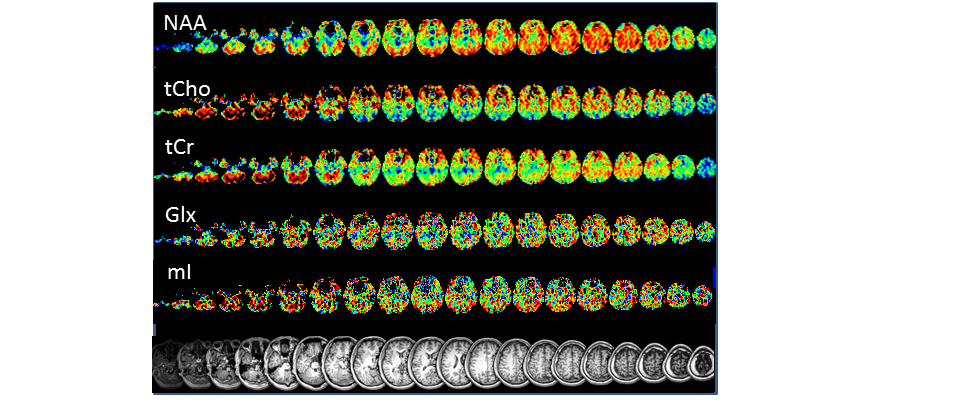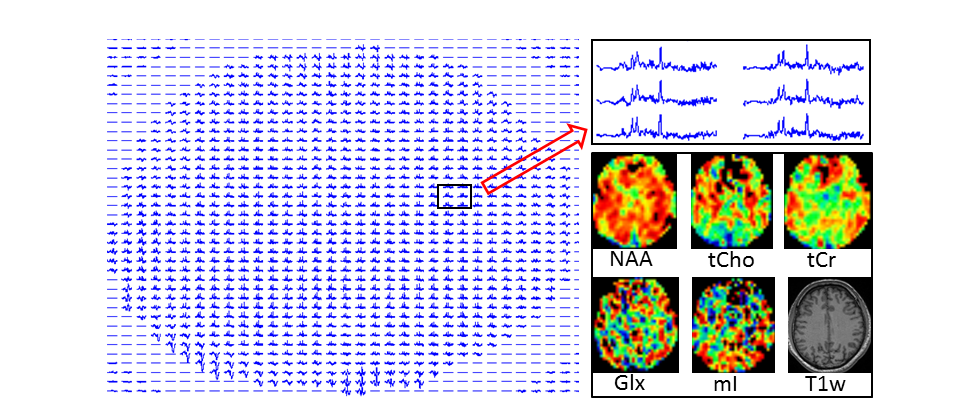AG "Quantitatives und Metabolisches Neuroimaging"
Leitung: Prof. Dr. med. Dr. rer. nat. X. Ding
Die AG Ding beschäftigt sich mit der Etablierung neuer MR-Verfahren, um die mikrostrukturellen und metabolischen Veränderungen im Gehirn in vivo zu detektieren und zu erforschen. Ein Forschungsschwerpunkt der AG ist das quantitative MR-Imaging (qMRI). Es wurden verschiedene quantitative Mapping-Verfahren als Tools für die wissenschaftliche Forschung und klinische Anwendung entwickelt bzw. optimiert, wie z.B. T1-, T2-, T2*- und T2‘- Mapping. In Kombination mit DTI ist das qMRI häufig in der Lage, die subtilen und deshalb in der konventionellen MRT nicht sichtbaren pathologischen Veränderungen bei verschiedenen neurodegenerativen Erkrankungen festzustellen. Ein weiteres Forschungsgebiet ist die 1H-MR Spektroskopie (1H-MRS). Mit 1H-MRS kann man die Konzentrationen von Metaboliten - wie dem N-Acetyl-Aspartat (NAA) als Marker für Integrität von neuronalem Gewebe, dem gesamten Cholin (Cho) als Marker des Membran-phospholipid-metabolismus, dem gesamten Kreatin (tCr) als Marker für den Energiemetabolismus oder dem Myo-Inositol (mI) als Marker für die Gliosis und als Osmolyt sowie dem Glutamin/Glutamat (Glx) als Neurotransmitter - in vivo im Gehirn bestimmen und Informationen über Neurometabolismus gewinnen. Allerdings können die bisherigen 1H-MRS Verfahren jedes Mal nur ein kleines Hirnareal untersuchen, und zwar mit einer relativen langen Untersuchungszeit. Dadurch ist der Einsatz von 1H-MRS limitiert. Als neuesten Erfolg hat die AG mit Hilfe einer von der DFG finanziell unterstützten internationalen Kooperation ein weltweit neuartiges Verfahren zum Ganzhirn-Magnetresonanz-Spektroskopie-Imaging (wbMRSI) in der MHH erfolgreich aufgebaut. Mit diesem wbMRSI können sogenannte Metaboliten-Maps für das gesamte Gehirn erstellt werden (Abbildung 1), die detaillierte Information über Metaboliten-Verteilungen im Gehirn enthalten (Abbildung 2). Mit diesem wertvollen Werkzeug können wir ganz neue Aspekte in der Erforschung des Neurometabolismus einbringen und neue/tiefe Kenntnisse z.B. über die physiologischen Alterungsprozesse in Gesunden oder über die pathologischen neurodegenerativen Prozesse in Patienten gewinnen.


As a physicist and medical doctor she has been/is principal investigator of different research projects founded by German Research Foundation (DFG) and Federal Ministry of Education and Research (BMBF), for example, the project “Classifying Leukodystrophies with unknown defects according to neuroradiological criteria: applications of MRI patterns and MRS characteristics” (BMBF), or the project “Assessment of metabolic and microstructural correlates in aging human brain and in patients by using an innovative whole brain 1H magnetic resonance spectroscopic technique in combination with quantitative magnetic resonance imaging” (DFG). She is experienced in Mössbauer spectroscopy, MR imaging and MR spectroscopy, and combines both professions - physics and medicine - in the scientific research.
1. Assessment of metabolic and microstructural correlates in patients with Parkinson’s disease and with major depression by use of whole brain 1H magnetic resonance spectroscopic technique in combination with quantitative magnetic resonance imaging
2. Influence of a 72 hours fasting on brain metabolism in healthy subjects and in patients
3. Quantitative MR brain morphological measurements in normal aging human and in patients
4. Physiological and pathological microstructural alterations in aging human brain studied with diffusion tensor imaging
Recent publications:
1. Reichardt, J. L., Dirks, M., Wirries, A. K., Pflugrad, H., Nösel, P., Haag, K., Lanfermann, H., Wedemeyer, H., Potthoff, A., Weissenborn, K. and Ding, X. Q. (2022). "Brain metabolic and microstructural alterations associated with hepatitis C virus infection, autoimmune hepatitis and primary biliary cholangitis." Liver Int 42(4): 842-852.
2. Ahlswede, M., Nösel, P., Maudsley, A. A., Sheriff, S., Mahmoudi, N., Bronzlik, P., Lanfermann, H. and Ding, X. Q. (2021). "Alterations of Striato-Thalamic Metabolism in Normal Aging Human Brain-An MR Metabolic Imaging Study." Metabolites 11(6).
3. Klietz, M., Elaman, M. H., Mahmoudi, N., Nösel, P., Ahlswede, M., Wegner, F., Höglinger, G. U., Lanfermann, H. and Ding, X. Q. (2021). "Cerebral Microstructural Alterations in Patients With Early Parkinson's Disease Detected With Quantitative Magnetic Resonance Measurements." Front Aging Neurosci 13: 763331.
4. Fu, T., Kobeleva, X., Bronzlik, P., Nösel, P., Dadak, M., Lanfermann, H., Petri, S. and Ding, X. Q. (2021). "Clinically Applicable Quantitative Magnetic Resonance Morphologic Measurements of Grey Matter Changes in the Human Brain." Brain Sci 11(1).
5. Stapel, B., Nösel, P., Heitland, I., Mahmoudi, N., Lanfermann, H., Kahl, K. G. and Ding, X. Q. (2021). "In vivo magnetic resonance spectrometry imaging demonstrates comparable adaptation of brain energy metabolism to metabolic stress induced by 72 h of fasting in depressed patients and healthy volunteers." J Psychiatr Res 143: 422-428.
6. Fu, T., Klietz, M., Nösel, P., Wegner, F., Schrader, C., Höglinger, G. U., Dadak, M., Mahmoudi, N., Lanfermann, H. and Ding, X. Q. (2020). "Brain Morphological Alterations Are Detected in Early-Stage Parkinson's Disease with MRI Morphometry." J Neuroimaging 30(6): 786-792.
7. Dirks, M., Pflugrad, H., Tryc, A. B., Schrader, A. K., Ding, X., Lanfermann, H., Jäckel, E., Schrem, H., Beneke, J., Barg-Hock, H., Klempnauer, J., Falk, C. S. and Weissenborn, K. (2020). "Impact of immunosuppressive therapy on brain derived cytokines after liver transplantation." Transpl Immunol 58: 101248.
8. Kahl, K. G., Atalay, S., Maudsley, A. A., Sheriff, S., Cummings, A., Frieling, H., Schmitz, B., Lanfermann, H. and Ding, X. Q. (2020). "Altered neurometabolism in major depressive disorder: A whole brain (1)H-magnetic resonance spectroscopic imaging study at 3T." Prog Neuropsychopharmacol Biol Psychiatry 101: 109916.
9. Pflugrad, H., Nösel, P., Ding, X., Schmitz, B., Lanfermann, H., Barg-Hock, H., Klempnauer, J., Schiffer, M. and Weissenborn, K. (2020). "Brain function and metabolism in patients with long-term tacrolimus therapy after kidney transplantation in comparison to patients after liver transplantation." PLoS One 15(3): e0229759.
10. Dirks, M., Haag, K., Pflugrad, H., Tryc, A. B., Schuppner, R., Wedemeyer, H., Potthoff, A., Tillmann, H. L., Sandorski, K., Worthmann, H., Ding, X. and Weissenborn, K. (2019). "Neuropsychiatric symptoms in hepatitis C patients resemble those of patients with autoimmune liver disease but are different from those in hepatitis B patients." J Viral Hepat 26(4): 422-431.
11. Maghsudi, H., Schmitz, B., Maudsley, A. A., Sheriff, S., Bronzlik, P., Schutze, M., Lanfermann, H. and Ding, X. (2019). "Regional Metabolite Concentrations in Aging Human Brain: Comparison of Short-TE Whole Brain MR Spectroscopic Imaging and Single Voxel Spectroscopy at 3T." Clin Neuroradiol.
12. Klietz, M., Bronzlik, P., Nosel, P., Wegner, F., Dressler, D. W., Dadak, M., Maudsley, A. A., Sheriff, S., Lanfermann, H. and Ding, X. Q. (2019). "Altered Neurometabolic Profile in Early Parkinson's Disease: A Study With Short Echo-Time Whole Brain MR Spectroscopic Imaging." Front Neurol 10: 777.
13. Dirks, M., Pflugrad, H., Tryc, A. B., Schrader, A. K., Ding, X., Lanfermann, H., Jackel, E., Schrem, H., Beneke, J., Barg-Hock, H., Klempnauer, J., Falk, C. S. and Weissenborn, K. (2019). "Impact of immunosuppressive therapy on brain derived cytokines after liver transplantation." Transpl Immunol: 101248.
14. Goede, L. L., Pflugrad, H., Schmitz, B., Lanfermann, H., Tryc, A. B., Barg-Hock, H., Klempnauer, J., Weissenborn, K. and Ding, X. Q. (2019). "Quantitative magnetic resonance imaging indicates brain tissue alterations in patients after liver transplantation." PLoS One 14(9): e0222934.
15. Maghsudi, H., Schutze, M., Maudsley, A. A., Dadak, M., Lanfermann, H. and Ding, X. Q. (2019). "Age-related Brain Metabolic Changes up to Seventh Decade in Healthy Humans : Whole-brain Magnetic Resonance Spectroscopic Imaging Study." Clin Neuroradiol.
16. Schmitz, B., Pflugrad, H., Tryc, A. B., Lanfermann, H., Jackel, E., Schrem, H., Beneke, J., Barg-Hock, H., Klempnauer, J., Weissenborn, K. and Ding, X. Q. (2019). "Brain metabolic alterations in patients with long-term calcineurin inhibitor therapy after liver transplantation." Aliment Pharmacol Ther 49(11): 1431-1441.
17. Ding, X. Q., Maudsley, A. A., Schweiger, U., Schmitz, B., Lichtinghagen, R., Bleich, S., Lanfermann, H. and Kahl, K. G. (2018). "Effects of a 72 hours fasting on brain metabolism in healthy women studied in vivo with magnetic resonance spectroscopic imaging." J Cereb Blood Flow Metab 38(3): 469-478.
18. Pflugrad, H., Schrader, A. K., Tryc, A. B., Ding, X., Lanfermann, H., Jackel, E., Schrem, H., Beneke, J., Barg-Hock, H., Klempnauer, J. and Weissenborn, K. (2018). "Longterm calcineurin inhibitor therapy and brain function in patients after liver transplantation." Liver Transpl 24(1): 56-66.
19. Schmitz, B., Wang, X., Barker, P. B., Pilatus, U., Bronzlik, P., Dadak, M., Kahl, K. G., Lanfermann, H. and Ding, X. Q. (2018). "Effects of Aging on the Human Brain: A Proton and Phosphorus MR Spectroscopy Study at 3T." J Neuroimaging 28(4): 416-421.